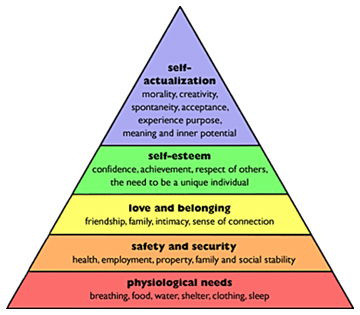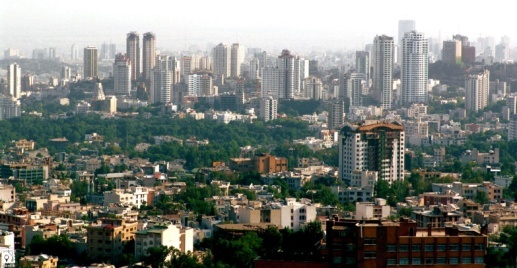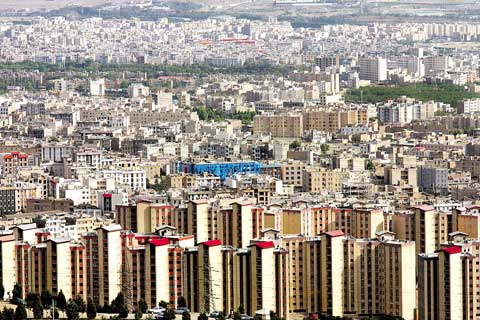-
Paper Information
- Previous Paper
- Paper Submission
-
Journal Information
- About This Journal
- Editorial Board
- Current Issue
- Archive
- Author Guidelines
- Contact Us
Architecture Research
p-ISSN: 2168-507X e-ISSN: 2168-5088
2015; 5(3): 102-105
doi:10.5923/j.arch.20150503.03
The Study of Environmental Psychology in Tall Buildings with Sustainable Architecture Approach
Hojjatollah Rashid Kolvir, Hossein Mohammadian Domola
Department of Architecture, Faculty of Engineering, University of Mohaghegh Ardabili, Ardabil, Iran
Correspondence to: Hossein Mohammadian Domola, Department of Architecture, Faculty of Engineering, University of Mohaghegh Ardabili, Ardabil, Iran.
| Email: |  |
Copyright © 2015 Scientific & Academic Publishing. All Rights Reserved.
The tall building model has been prevalent considering population growth and urbanization, today. Due to accumulation of users in a limited area and enjoying a lot of energy in buildings, the need for sustainability in architecture and urbanize both design process and utilization should be considered. Although the design of a tall building is with the end results a complex process, mutual influence on each other. Several factors influence, including the characteristics of the cultural, social and economic. However the principles and norms of basic and applied research can be established appropriate use of tall buildings in the fields of architecture, urban planning, and psychology. This paper is a short overview of the development of environmental psychology and its relation deals with the physical design of tall buildings along with how user interaction. In the following, we try to express the relationship between human behavior and the physical environment and the importance of understanding this relationship is to design purposes. In conclusion, this study puts the main index charts Maslow's basic needs to identify strategies for the development of sustainable practices.
Keywords: Urbanization, Tall building, Environmental psychology, Sustainable architecture
Cite this paper: Hojjatollah Rashid Kolvir, Hossein Mohammadian Domola, The Study of Environmental Psychology in Tall Buildings with Sustainable Architecture Approach, Architecture Research, Vol. 5 No. 3, 2015, pp. 102-105. doi: 10.5923/j.arch.20150503.03.
Article Outline
1. Introduction
- With the rapid economic growth and urbanization, the tall building construction boom started in middle of the 20th century. In fact, the 20th century is related to the phenomenon of rapid urbanization (UN Population Division). Owing to the wide variety of social requirements for commercial or aesthetic purposes, the limited availability of land, and the preference for centralized services, the height of tall buildings has grown taller, and the configuration as well as a structural system has become more complex in recent years, which brings more difficulties in structural analysis and design. In fact, what they consider to be tall buildings, is making use too much from energy. The importance of this paper is based on sustainability in the context of the built environment with primary emphasis on consumption of physical resources, wherein a sustainable building is one that improves occupant health and performance, minimizes energy and material consumption, and stimulates a healthy ecosystem. Therefore, it is essential to be examined strategies the correct use of these buildings to improve energy sustainability. Traditionally, tall buildings consume a great number of resources. These massive structures are dependent on large quantities of building materials during construction, require considerable amounts of energy to operate, and produce a great deal of waste when they reach the end of their life cycle and are demolished. Over 75% of the energy consumption in tall buildings is allocated for heating, ventilation, and air conditioning (HVAC) [18]. Energy efficiency over the entire life cycle of a building is the most important goal of sustainable architecture. This means that sustainable architecture is one of the most important in the design of tall buildings. In addition to knowing of dimensional architecture of such physical and mental conditions is necessary to recognize as the correct way. In fact, basis of formation of behaviors is human needs [1]. So, Maslow [2] presented a theory based on human needs in which human needs to be classified in five stages. The five stages are appropriate recognition of needs to promote environmental psychology with sustainable physiological, safety, love and belonging, esteem and self-actualization. Therefore, it is necessary, appropriate recognition of needs to promote of sustainable behavior throughout users. Many of the behavioral issues encompassing sustainable design have been addressed in existing research on the impact of human behavior on energy and water conservation, creating green space. The paper addresses the importance of the sustainable architecture approach in studying of environmental psychology in tall buildings. Review of literatureSustainable architecture is an architecture that seeks to minimize the negative environmental impact of buildings by efficiency and moderation in the use of materials, energy, and development space. Sustainable architecture uses a conscious approach to energy and ecological conservation in the design of the built environment [3]. In this research, sustainable architecture is carried out based on environmental psychology in tall buildings. Tall buildings provide high-density developments that satisfy increasing demands for office spaces in city centers. As Reddy pointed out, “it appears that this is the only rational way of redevelopment that could be adopted” [4]. “Tall buildings appear to become a phenomenon of modern cities.” [5].The tall building has that in common with all major works of architecture consciously conceived in aesthetic terms [6]. Tall buildings do not only satisfy a functional need, but they are also sources of national pride, cultural identity and environment psychology ascribe to other countries. In fact, environmental psychology plays a role important in tall buildings. Environmental psychology is a subset of the behavioral sciences as a branch of psychology that architects also have a stake in its development [7]. This new knowledge with other names is such as human relations, sociology, also known as environmental and human ecology. According to Craik theory, soul cognitive psychology, environmental studies human behavior in such a way that is relevant to everyday life in the physical environment. People have a fundamental role, such as perception, cognition, and behavior space [7]. In the decade between 60 and 70 , study the effect of “human environment” were designed, as a specialized field of study “ an environment of soul”, “soul environment”, with “the science behavior” was published [8].
2. Research Methodology
- The review articles and more analytical and descriptive information to the style library and information resources available in books and articles are collected. This study first examines the environmental psychology, and then expresses a sustainable approach to tall buildings. In this regard, the role of environmental psychology carried out in the design of tall buildings with a sustainable approach to the recognition. Therefore, human needs that have a form and a regulator factor of human behavior are recognized adequately. As a result of this article, according to Maslow's pyramid model needs and levels that are related to the need for sustainable behavior to identify practices and strategies to promote sustainable behavior by its users. In this regard, it is necessary mental and physical needs to be recognized as the correct way. Physical needs of people with knowledge of the performance criteria established by the designers, standards and similar functions can be investigated, in the field of environmental psychology, Abraham Maslow's model of the "pyramid of human needs" is known for use in architectural design has been approved [9]. Maslow [2] stated that people are motivated to achieve certain needs. When one need is fulfilled as a person seeks to fulfill the next one, and so on.The earliest and most widespread version of Maslow's [2] [10] hierarchy of needs includes five motivational needs, often depicted as hierarchical levels within a pyramid. This five stage model can be divided into basic (or deficiency) needs (e.g. physiological, safety, love, and esteem) and growth needs (self-actualization). The deficiency or basic needs are said to motivate people when they are unmeted. Also, the need to fulfill such needs will become stronger the longer the duration they are denied.
 | Figure 1. Maslow's model of the pyramid of human needs |
3. Environmental Psychology
- Environmental psychology is the study of transactions between individuals and their physical settings [11]. In these transactions, individuals change their environments, and their behavior and experiences are changed by their environments. The psychological processes that an individual undergoes when set in an artificial environment may also offer some suggestions when trying to overcome the problem of affecting sustainable behavior in building occupants. The built environment plays an extremely important role in the cognitive reactions of an individual, and an understanding about this relationship can help to determine and predict the activity and behavior of a building’s occupant. The development of environmentally friendly behavior in building users are extremely complicated task, and one that cannot be accomplished easily or simply.It includes theory, research, and practice aimed at making the built environment more humane and improving human relations with the natural environment. As a cited above, Environmental psychology is a subset of the behavioral sciences as a branch of psychology that architects also have a stake in its development. Knowledge of environmental psychology, like many other scientific disciplines, including both theoretical and practical application or the fact that the dimension detection in general psychology is forgotten; dimensional architecture of such physical conditions, as well as social and cultural dimensions environmental symbol. Fields of application of this knowledge, designers and architects can serve as an effective and results can be obtained, may play an important role in the architectural design process. From an environmental, psychological perspective, buildings are physical forms that, in Bechtel’s terms, ‘enclose behavior’. That is, buildings provide facilities and shelter from the elements to support human activities. They are designed to provide for human behavior, psychological, and social needs. Whether or not they are successful depends in large part on the degree to which designers accurately understand and predict what activities are required and likely to occur, and their ability to use this knowledge to create space and facilities to support their predictions. According to aforementioned the designers in order to resolve the needs of customers and consumers of designing spaces caused that familiar of psychology is begun with professional design. And as a result, new knowledge and paradigm of environmental psychology is studied.
4. Sustainable Architecture Approaches
- Sustainable buildings may differ from these earlier conservation strategies in the way that many or all of these issues are addressed collectively to try and create a ‘no-impact’ building. There is, as yet, little experience to indicate whether user responses are different when addressing many or all of these issues at once. Psychological research on conservation issues has taken two broad approaches: social psychology studies, which focus on attempts to understand and change attitudes; and applied behavioral analyses, which assess critical behavioral contingencies.
4.1. Approaches
- Signs suggesting turning off room lights can be very effective when they are visible to users as they are exiting from the room [12]. Other approaches have provided information about the consequences of energy consumption at the point of use. Opening windows should be so light that in addition to a landscape view as possible. Becker and Seligman [13] placed a light in the kitchen that went on when the air conditioner was operating but outside temperatures were cool. Others have offered residents daily written information on the amount of electricity used or installed prominently placed and easy to read meters that show energy costs in real-time [14]. Evaluations have suggested that these techniques may result in a significant reduction of overall energy use or during peak time use [15]. Creating green space (vegetation in this region of around tall building, where the volume of the water views) that exists. The designer with using this approach can be designed using the vacuum separation of users and the natural environment to compensate for its adverse effects on behavior). In fact views of nature reduced stress and positively affected recovery from illness [16] [17]. Color (Colors are forces that can affect the human performance and the psychological effects of the changing interests of the human psyche and sense of satisfaction or dissatisfaction and eventually be absorbed by the audience).For example, these figures show the difference of lack of the green space and compact space. As seen in figure (2a, b) creating the green space is an important role in evnvironmental psycology .So that causes positive emotions such as love or gratitude, spending time in natural settings can have positive psychological effects [19]. These findings by showing that the presence of vegetation in public housing sites is significantly associated with reduced levels of aggressiveness and crime [20]. In fact, green space can be reduced the stress and adverse effects on behavior.
 | Figure 2a. The tall buildings with green space |
 | Figure 2b. The tall buildings without green space |
5. Conclusions
- From this brief review it is clear that the behavior of residents and tenants of a sustainable facility is likely to play a significant role in determining the degree to which the building succeeds in meeting its goals of reduced impact on the environment and resources, although the precise level of impact needs attention in future research. Environmental psychology, along with other behavioral science has an important role in the designing space, tall buildings and this allows designers presented their plans more than accommodate the needs and culture of users and environments designed for humans, they have the necessary conditions that people enjoy from the environment because of its structure, current patterns of behavior and physiological well-being required them to provide their desires and in fact is accountable. According above discussion, environmental psychology in sustainable architecture approaches can be fulfilled in sustainable buildings. Once inside these buildings, occupants become significantly dependent on technology for air, light, and even the shortest of trips. Moreover, as discussed, the larger the structure, the more those in it are disengaged from natural elements. There is increasing evidence that such separation has negative consequences for psychological states and behavior resulting in poor health and productivity loss. Therefore, the approaches proposed to achieve this goal are that the architects in addition to physical and psychological needs. In this case, it must be used the creating green space, color, energy, water, and waste systems in the building to provide the suitable strategies for users and observers of this space. It was concluded that architects should try to redress the separation from the natural environment commonly experienced by occupants of traditional mega-structures.This can be accomplished by providing easy and multiple options to access daylight and vegetation without having to leave the building, providing increased ventilation to the outside air and decreased presence of toxic materials, and by maximizing access to window light and views. This incentive strategy is an effective factor to attract people with various purposes and the sense of satisfaction. To sum up, the role of psychological processes of an individual in determining the activities and behaviors of that individual in a given environment.
 Abstract
Abstract Reference
Reference Full-Text PDF
Full-Text PDF Full-text HTML
Full-text HTML